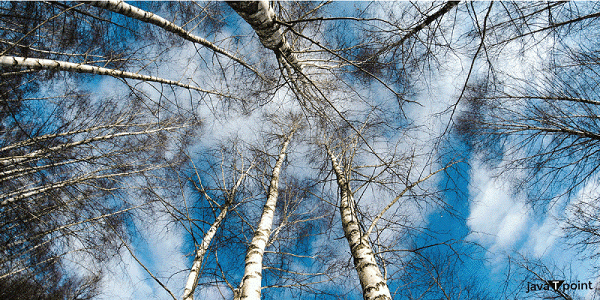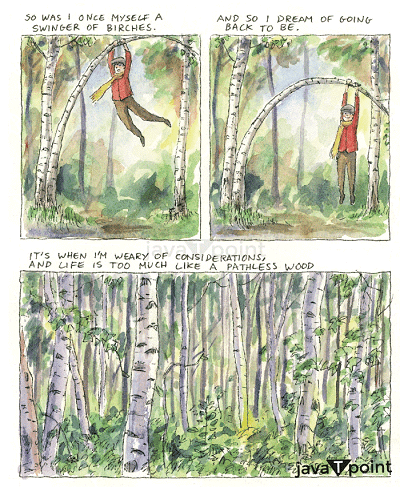Birches Summary & Analysis by Robert FrostStanza 1When I see birches bend to left and right Across the lines of straighter darker trees, I like to think some boy's been swinging them. But swinging doesn't bend them down to stay As ice-storms do. 
Explanation to these lines: The poem's first four lines begin with a straightforward illustration of the birches. In the author's description, they are described as "left and right/ Across the line straighter darker trees." The poet contrasts the mundane and uninteresting sight of birches trees with a fascinating image of them benching downwards towards the earth. As we have a closer look at the imagination of the writer, birches have thin trunks and so they bend easily in the wind and under the weight of the snow storm, showcasing their beauty. The poet begins to imagine that the boy had been swinging on them and his belief got stronger when he had a closer look at the birches and the structure that they had, they were bending to the left and right across the lines of taller and darker trees in the wood. In line number 4 the poet acknowledges that the act of swinging from the Birch trees would not actually make the trees look bent in the way that they look now. He indicates that the ice storms can bend down the trees enough to cause them a permanent bent. Stanza 2Often you must have seen them Loaded with ice a sunny winter morning After a rain. They click upon themselves As the breeze rises, and turn many-colored As the stir cracks and crazes their enamel. Soon the sun's warmth makes them shed crystal shells Shattering and avalanching on the snow-crust? Such heaps of broken glass to sweep away You'd think the inner dome of heaven had fallen. Explanation to these lines: In these beautiful lines, the poet beautifully imagines birch trees covered in the ice on a sunny winter morning; it is a stunning sight. Here, the poet acknowledges that the birches are genuinely bent because of the storm and not because of a boy was being playful and swinging on those trees as he had thought earlier. The poet claims that; you must have frequently observed birches filled with ice in the bright winter morning following rain. The tree is covered in a film of ice by the rain, which eventually turns into a translucent coating of freezing enamel around the entire tree. He showcases the movement of birches- Birches move up and don while making a clicking noise as the wind blows. The ice on the birches is shaken and breaks down into small little fragments that fall down on the land. Here, the breaking ice has been compared to the shattering crystals and glass that falls like an avalanche. The poet showcases this in a beautiful manner by showing that the shattered ice crystals get collected below the tree as if it were a pile of glasses that are to be swept away. Metaphor: It has to be noted that the poet uses the metaphor: The snow crystals have been compared to the broken pieces of glass because of their transparency and the same amount of sharpness that a broken piece of glass has when it breaks down into pieces. The speaker, then imagines the ice crystal scattered around the tree as the inner "Dome of heaven" has fallen on land. Stanza 3They are dragged to the withered bracken by the load, And they seem not to break; though once they are bowed So low for long, they never right themselves: You may see their trunks arching in the woods Years afterwards, trailing their leaves on the ground Like girls on hands and knees that throw their hair Before them over their heads to dry in the sun. 
Explanation of these lines: In these lines, the poet says that the birches are bent as a result of the weight of the ice and snow till they touch the ground-level withered ferns and shrubs. The poet claims that because of their extreme bending, birches "seem not to break" but can "never right themselves," which illustrates how bent they are. This indicates that the trees are deeply and persistently bent to the point that they are unable to straighten themselves. Stanza 4But I was going to say when Truth broke in With all her matter-of-fact about the ice-storm I should prefer to have some boy bend them As he went out and in to fetch the cows? Some boy too far from town to learn baseball, Whose only play was what he found himself, Summer or winter, and could play alone. Explanation of these lines: In these lines, the poet uses his imagination to demolish his idea of ice storm as a cause of bowing down of the trees. The poet says that although he accepts the reality that the birches trees are bend down due to the heavy snow storm, but still he would like to prefer there bent due to the boy who herds the cows. The poet says that the boy might have swung them in his ideal time. The poet thinks that the boy, in his regular day time, herds the cows, lives far away from his home town to learn baseball. As the hardworking boy lives far away from the city and learns baseball, he must not have much friends to spend some time. Due to his situation, he might have thought of an idea of playing a game known as the "game of birds swinging ". This game could be enjoyed by the boy alone in the summer and in the winter season too. Stanza 5One by one he subdued his father's trees By riding them down over and over again Until he took the stiffness out of them, And not one but hung limp, not one was left For him to conquer. He learned all there was To learn about not launching out too soon And so not carrying the tree away Clear to the ground. Explanation to these lines: Through these lines, the poet expresses the theme "conquest of nature". According to the poet, the boy who take care of the cows, has found the game of birds swinging very thrilling. The youngster made the decision to climb every birch that belonged to his father, one by one bending them down as though he intended to rule them. The boy keeps bending the birch trees until he removes all their stiffness. This gives him complete victory over the trees, and he is pleased with his conquest of them. Not even a single tree was left for him to vanquish in the queue. The poet describes how there were no longer any trees that could stand up straight because all of their rigidity and stiffness has vanished away. Using his imagination, the port claims that the youngster finally learns to climb all the way to the top of the tree and to avoid bending it before he has reached the summit. Stanza 6He always kept his poise To the top branches, climbing carefully With the same pains you use to fill a cup Up to the brim, and even above the brim. Then he flung outward, feet first, with a swish, Kicking his way down through the air to the ground. Explanation to these lines: The poet imagination depicts the technique of climbing and bending of the trees. According to the poet, the boy should take as much care and pain to maintain his balance or posture to reach the top of the tree, and to bend the birches tree to the perfection. He compares this to the similarity that we can see while we are filling up a cup to the brim and even, we try to fill the cup above the brim by taking a lot of care. Through these lines, we get to know about the poet's willingness to reach beyond the limits to a realm beyond the real situation. We get to know this as the lines depict a feeling of filling up a cup to the brim and even above the brim which depicts the poet's willingness to reach beyond the limits in the real life situation. Stanza 7So was I once myself a swinger of birches. And so I dream of going back to be. It's when I'm weary of considerations, And life is too much like a pathless wood Where your face burns and tickles with the cobwebs Broken across it, and one eye is weeping From a twig's having lashed across it open. 
Explanation to these lines: These lines depict the loneliness of the poet to get back his childhood. These lines tell a contrast between the simple, easy life that a person experiences in their childhood and also depicts the pain that is hidden in the adult world. The poet says that once he himself was a swinger of birches and now when he has grown up he once again wants to enjoy this swing. The poet uses the simile of "pathless wood" for adult life. It has to be noted, that through the simile, the author depicts that the adult life that he is experiencing; he has become tired of his thoughts and his life is becoming hard to live, whereas the cobwebs of confusion and a certainty troubles him just like some twig pinches his eyes and his "one eye is weeping". The author feels that his life has become like a pathless board where he has lost his path to come out of it. It has to be noted that the word weeping used by the poets suggest that the tears do not come simply as a result of a wound or cut, but it is because of the inner thoughts that are troubling him or we can say some inner sorrow that the poet is experiencing. Pathless wood, cop web, weeping, are the metaphors that are used by the poet to describe his hardships that he is facing in his adulthood. Through these lines, the poet also shows the theme of imagined world vs the reality of the adult world. He depicts the reality by showcasing the boy's birch climbing experience which represents the playful time and the world of imagination. On the other hand, his coming down to the ground represents the reality of the present world. Stanza 8 and 9Broken across it, and one eye is weeping From a twig's having lashed across it open. I'd like to get away from earth awhile And then come back to it and begin over. May no fate willfully misunderstand me And half grant what I wish and snatch me away Not to return. Earth's the right place for love: I don't know where it's likely to go better. I'd like to go by climbing a birch tree, And climb black branches up a snow-white trunk Toward heaven, till the tree could bear no more, But dipped its top and set me down again. That would be good both going and coming back. One could do worse than be a swinger of birches. Explanation to these lines: In these lines the poet-has a will to escape from this earth for a time being.These lines showcases that the poet is tired of his difficult and complicated adult life and now he wants to go back to his childhood.He wants to become a Birch swinger once again and wants to relive his childhood-he has a will of becoming a bird swinger once again-so that he can forget the difficulties that he is facing in his Adult life, he wants to swing once again in the birches tree and wants to relive his childhood. Through these lines we get a clear picture that the author wants to escape himself into an imaginary world. But it also contradicts his own statement by giving us a picture that he does not want to escape permanently from the real world, he wants to come back to the earth and resume his earthly duties. The poet depicts all these feelings through the word "half grant" which depicts that the poet wants to fate to half grant him a wish to go away from this world come up from his responsibilities and live a tension free childhood full It has to be noted that the word half grant Is of importance here as he does not want to go away permanently from this world.The reason that he wants to come back to the earth despite having all these childhood and imaginary world, is that he knows that the right place for love is earth and due to this reason he wants to come back to the planet earth.Through this way, the poet recognises the fact that there is no better place than the real world itself it shows you reality but it also gives you love.The limits of the real world must exist to enable the imaginative world which makes possible the fantasies of a poetic imagination only. Analysis of the PoemThe birches poem was written by Robert Frost in the year 1931 and 1914, and got this mesmerizing piece published in The Atlantic Monthly's August issue in 1915. Later, The Birches was introduced in the Frost's third collection of poetry, Mountain Interval. The poem Birches has 59 lines of "blank verse". It is said as the depiction of blank verse as the poet showcases the imagination that the boy makes the birches tree bend down by holding them from the flexible treetops. Through such lines, it has been depicted by the professionals that the poet used to swing on the birches tree in the same way the boy does and is having a nostalgia by celebrating his childhood. There are 3 points that have to be seen in the poem, which will also showcase the analysis of the poem: 1. The Joy of ChildhoodThis wonderful piece showcases the children's ability to find joy and playfulness in small little things. The poet explains the fun that one experience in the childhood through his beautiful poetry. Frost showcases that the birches tree are bent like this not because of the heavy snow storm but because of the boy who enjoys swinging of them in his free time. The speaker admires how children are able to find fun in small, little things that we can also see while we are at the adult age but don't have ideas to enjoy them. For instance, the speaker might assume that the youngster dangling from the trees doesn't live close enough to the city to play baseball and is therefore left to fend some joy from himself. But despite this, the young child continues to live his life with full enjoyment. Instead of mechanically going through his responsibilities, the boy discovers a creative way to harness the pathway of happiness. The speaker adores the wonderful thing that children have a childish capacity for happiness and enthusiasm. 2. The Reality of AdulthoodThe speaker portrays maturity and adult life as uninteresting, demanding, and weighted down by tedious details and obligations. For this reason, the speaker longs for the imaginative years of childhood, when it is quite easy to set aside the pendulum of daily life in favour of a more creative, playful environment. The speaker also implies that people's ability to enjoy the world in original, spontaneous ways is being eroded by the mundane realities of adult life. The Birches are twisted as they are covered with ice, but the speaker would rather believe that a boy has been swinging through them and has caused them to droop down deeply. This indicates that the speaker is missing his younger days and wants to overlook the mundane facts of daily life. Through the line, "I should prefer to have some boy bend them," the poet demonstrates a deliberate attempt to ignore the reality. The speaker shows a wish to have a look at the world with surprise and joy rather than only using specified reasons. 3. Death, Spirituality, and EscapeIn some ways, the speaker conveys a willingness to let go of life and seems prepared to accept the truth of life- The Death. But he later on contradicts his own statement by choosing to cling to worldly life rather than the potential allure of heaven. It becomes quiet apparent that the speaker craves for the sublime release that death would offer to him. Ultimately the speaker does not want to give up the pleasure of being alive and wants to encounter the amazing emotions of love, wonder, and joy. ConclusionBirches poem is an amazing masterpiece written by Robert Frost and this poem was inspired from, "Swinging on a Birch Tree", which was written by Lucy Larcom in the 19th century. The difference between the two poems is that the Larcom's poem was simply, light, and cheerful. On the other hand, Birches is long and a thoughtful poem. |
 For Videos Join Our Youtube Channel: Join Now
For Videos Join Our Youtube Channel: Join Now
Feedback
- Send your Feedback to [email protected]
Help Others, Please Share









